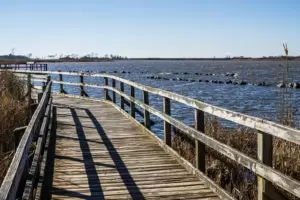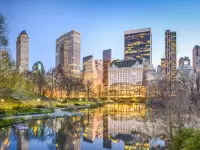
A wetlands designer is a specialized environmental professional who plans, creates, and restores wetland ecosystems for conservation, water quality management, and wildlife habitat. These professionals typically earn between $50,000-$135,000 annually depending on experience and location, with a median around $80,000. A bachelor's degree in environmental science, ecology, or landscape architecture is required, with master's degrees preferred for senior roles and project management positions.
Wetlands face mounting pressures from development, climate change, and water pollution-yet these critical ecosystems provide flood protection, water filtration, and essential wildlife habitat. Wetlands designers work at the intersection of engineering, ecology, and conservation to create, restore, and protect these vital landscapes. If you're passionate about environmental work that produces tangible, visible results, wetlands design offers a rewarding career path combining technical skills with hands-on conservation impact.
A wetlands designer is a specialized type of environmental engineer who plans, designs, and oversees the creation and restoration of wetland ecosystems. Unlike wetland specialists who primarily focus on assessment and regulatory compliance, wetland designers handle the engineering and planning aspects-determining optimal locations, designing water-flow systems, selecting native plant species, and ensuring long-term ecosystem viability.
What Does a Wetlands Designer Do?
A wetland is defined as an area of land where the soil is saturated with water. This can apply year-round, throughout the day with the tides, or seasonally. Flocking bird species use these lands at certain times of the year, feeding and breeding before moving on, while some species live permanently in wetlands.
In these environmentally aware times, professional environmental scientists, ecologists, and conservationists work to restore and preserve sensitive landscapes such as wetlands and to create new ones. In some cases, agricultural engineers may have drained the land to make space for farming. This is now recognized as endangering particular species. In other cases, there may be a desire to create wetlands for conservation, tourism (such as zoos, safari parks, or artificial wildlife parks), or academic research-sometimes a combination of all three. Zoologists are excellent examples of professionals who combine tourism, research, and conservation.
A typical week for a wetlands designer might involve conducting field site assessments, developing restoration plans using GIS and CAD software, coordinating with regulatory agencies to obtain permits, and presenting design proposals to conservation organizations or private clients. One day, you might be surveying a degraded marsh, determining hydrology patterns and soil composition. Next, you're in the office using specialized modeling software to design a water distribution system that mimics the functions of a natural wetland. Throughout projects, you'll collaborate closely with ecologists, environmental planners, and regulatory specialists to ensure designs meet both ecological goals and legal requirements.
Wetlands designers are, at heart, landscape engineers with a focus on ecology and environmental issues, required to reconstruct natural environments or create sustainable landscapes that mimic natural wetlands as closely as possible to encourage wildlife and overall ecology. They work in teams of engineers, alongside landscape designers, stratigraphers, and planners, to design and implement landscapes. Swamps, wetlands, river floodplains, and salt marshes are havens for species either seasonally or permanently.
Wetlands design appeals to environmental professionals who enjoy both the technical challenges of engineering and the biological intricacies of ecosystem management. If you're drawn to work that produces visible environmental results-such as a restored marsh attracting migrating waterfowl or a constructed wetland naturally filtering stormwater-this career offers tangible rewards.
Where Does a Wetlands Designer Work?
Wetlands designers are a type of landscape architect. Therefore, statistics for this type of employee are likely to reflect similar employment patterns. According to industry data, approximately 49% (just under half) work for architectural services, engineering firms, and related companies. Their training means they are landscape engineers at heart with a focus on ecology and environmental issues required to reconstruct natural environments or to create sustainable landscapes.
About 15% (just less than one-sixth) work in landscape services-typically in conservation and ecological work. They are less about engineering than about the conservation and mitigation of human actions. They work to create, maintain, and promote existing lands. They may be involved in cleanup operations, risk identification, and manual labor such as scrub clearance.
Approximately 20% (one-fifth) are self-employed, working as consultants, advisors, and contractors for the other industries already highlighted here. They also work independently, taking on small parts of individual contracts such as construction for developments and extensions of existing wetland areas. These professionals are often generalists with diverse project experience.
The remaining professionals work for federal and state agencies (such as the EPA, Army Corps of Engineers, and state environmental departments), non-profit conservation organizations, water management districts, and academic research institutions. Each sector offers distinct advantages: government positions provide stability and comprehensive benefits, consulting offers variety and higher earning potential, while non-profit work emphasizes conservation mission over compensation.
Wetlands Designer Salary & Compensation
Salary for wetlands designers varies based on experience, location, employer type, and the specific occupational category they fall under. Since wetlands design sits at the intersection of landscape architecture, environmental science, and environmental engineering, compensation data comes from multiple BLS categories.
Environmental Scientists and Specialists (which includes many wetlands-focused professionals) earned the following, according to May 2024 BLS data:
- Median Annual Salary: $80,060
- Entry Level (10th Percentile): $50,130
- Experienced (75th Percentile): $103,730
- Top Earners (90th Percentile): $134,830
- Mean Salary: $88,640
Geographic salary significantly impacts earnings. Wetlands designers in coastal states, areas with extensive wetland systems (such as Louisiana, Florida, and the Chesapeake Bay region), and areas with strong environmental regulations (like California and the Pacific Northwest) typically command higher salaries. Professionals working in federal government positions or for major ecological consulting firms generally earn at the higher end of the range.
Factors affecting salary Salarye:
- Education lSalaryMaster's degree holders often earn 15-25% more than bachelor's degree holders
- Certifications: Professional Wetland Scientist (PWS) or Professional Engineer (PE) credentials can increase earning potential by 10-20%
- Sector: Federal agencies and private consulting firms typically pay more than non-profits or state/local government
- Experience: Senior project managers with 10+ years of experience earn significantly above the median
- Specialized skills: Expertise in emerging areas like climate resilience design, blue carbon markets, or advanced hydrologic modeling can command premium compensation
Typical Job Duties & Responsibilities
Wetlands designers share many job duties with biologists, urban planners, and water engineers, working on complex projects to create new wetlands that improve water quality and support biodiversity. Responsibilities vary by experience level: entry-level designers focus on field assessment and data analysis, while senior designers manage projects and provide technical direction.
Design & Planning:
- Conduct feasibility studies for the construction of new engineered wetlands
- Design water distribution systems, pumping stations, pipelines, and water control structures
- Create restoration plans using GIS and CAD software
- Select appropriate native plant species and determine planting strategies
- Design systems for both potable and non-potable water management
Field Assessment & Analysis:
- Perform wetland assessments and delineations with strict adherence to federal and state environmental regulations
- Analyze stormwater or floodplain drainage systems to control erosion and stabilize river banks
- Conduct site investigations and gather environmental data
- Monitor soil composition, hydrology patterns, and existing vegetation
- Use drone technology and LiDAR for topographic surveys
Regulatory & Project Management:
- Prepare technical reports and permit applications (particularly Clean Water Act Section 404 permits)
- Present field investigation results to project managers and regulatory agencies
- Provide technical direction or supervision to junior engineers or CAD technicians
- Coordinate with the Army Corps of Engineers, EPA, and state environmental agencies
- Ensure compliance with federal and state wetland protection regulations
Job Outlook & Career Growth
The employment outlook for wetlands designers reflects steady demand driven by multiple converging factors. According to recent BLS projections, landscape architects and environmental scientists-the two primary occupational categories for wetlands designers-show stable to moderate growth through 2032.
Environmental scientists and specialists are projected to grow by approximately 6% from 2022 to 2032, about as fast as the average for all occupations. This translates to roughly 7,000 job openings annually, accounting for both growth and replacement of workers who retire or change careers. For landscape architects, employment is projected to grow about 4% during the same period.
Several factors are driving continued demand for wetlands design professionals:
- Climate Change Adaptation: Increasing focus on wetlands as natural buffers against coastal flooding, sea-level rise, and extreme weather events
- Infrastructure Investment: Federal and state funding for green infrastructure projects that incorporate wetland systems for stormwater management
- Regulatory Requirements: Strengthened enforcement of wetland protection laws and "no net loss" policies requiring mitigation wetlands for development projects
- Corporate ESG Initiatives: Growing corporate environmental, social, and governance (ESG) commitments are driving private-sector wetland restoration projects
- Water Quality Management: Expanded use of constructed wetlands for wastewater treatment and agricultural runoff filtration
Geographic opportunities concentrate in coastal regions, areas with extensive wetland resources (Gulf Coast, Great Lakes, Mid-Atlantic), and states with active restoration programs (Florida, Louisiana, California, Maryland). Competition remains moderate, with candidates possessing strong technical skills, relevant certifications, and interdisciplinary knowledge having the best prospects.
Education & Certification Requirements
Finding your path into wetlands design requires strategic planning. Your unique combination of interests-whether you're more drawn to hands-on fieldwork, computational modeling, or policy implementation-will guide your educational choices.
High School Preparation:
Students wishing to enter this career should focus on environmental science-based subjects. Geography is essential, as are biology and chemistry. Any available environmental courses will be helpful. These science subjects form the basis of your scientific training and should receive significant attention. Mathematics (particularly calculus and statistics) provides the foundation for hydrologic modeling and spatial analysis.
Bachelor's Degree Requirements:
A bachelor's degree is required for entry into this field. There are several relevant degree paths for students wishing to pursue this career:
- Ecology: Most colleges and universities offer ecological degrees or equivalents today, providing strong biological and ecosystem science foundations
- Environmental Science: Broad-based programs covering multiple environmental disciplines, ideal for wetland-focused specialization
- Landscape Architecture: Emphasizes design principles and spatial planning, with opportunities to specialize in ecological design.
- Environmental Geoscience: Strong in hydrology, soil science, and spatial analysis-critical for wetland hydrology work
- Environmental Architecture: Combines design with ecological systems thinking
- Sustainability: Increasingly popular programs focusing on sustainable landscape systems
- Environmental Planning and Design: Where available, these programs directly prepare students for wetland design careers
Graduates spend considerable time in offices working with technology. Therefore, students should take minors and electives in subjects such as GIS and CAD, ecology, and geography (where this is not a major). Coursework should include hydrology, soil science, plant ecology, and environmental law.
Master's Degree Considerations:
While not always required, a master's degree is increasingly preferred for project management roles, senior positions, and specialized design work. Master's degrees are beneficial for students wishing to manage projects, spend more time on research, or pursue decision-making roles. Students may specialize in areas such as wetland ecology, hydrologic engineering, landscape architecture, or environmental planning and design.
Many professionals follow a strategic path: earn a bachelor's degree, gain 2-3 years of field experience, then pursue a master's degree with clearer career direction and often employer support. This approach combines practical knowledge with advanced theoretical training.
Doctoral Programs:
Doctoral programs are suitable for students seeking roles in local government decision-making, some Federal positions (NPS, NASA, EPA), and corporate decision-making. Students who wish to teach at the university level and engage in academic research should pursue a PhD. Doctoral work in wetland science often focuses on specific restoration techniques, climate adaptation strategies, or wetland biogeochemistry.
Professional Certifications:
While not always required, professional certifications demonstrate expertise and can significantly enhance job prospects and earning potential:
- Professional Wetland Scientist (PWS): Offered by the Society of Wetland Scientists, this certification validates expertise in wetland science and management. Requirements include education, experience, and professional references.
- Professional Engineer (PE) License: For those working in the engineering aspects of wetland design, PE licensure demonstrates technical competency and may be required to sign off on engineering plans.
- Certified Ecologist: Offered by the Ecological Society of America, recognizing ecological expertise
- LEED Accreditation: For professionals working on sustainable development projects incorporating wetland systems
Emerging Skills & Technologies:
Modern wetland designers increasingly use advanced technologies that weren't common even a decade ago:
- Drone Technology: Unmanned Aerial Vehicles(UAVs) for site surveys, vegetation monitoring, and progress documentation
- LiDAR: Light Detection and Ranging for high-resolution topographic analysis and hydrologic modeling
- Climate Modeling Software: Tools for designing wetland systems resilient to future climate conditions
- Advanced GIS Applications: 3D modeling, temporal analysis, and predictive habitat mapping
- Hydrologic Simulation Programs: Specialized software for modeling water flow, sediment transport, and nutrient cycling
Familiarity with these tools can set you apart in the job market. Many universities now incorporate drone operation and advanced geospatial analysis into their environmental science curricula.
Practical Experience:
Fieldwork is essential to early career development. Seek internships with environmental consulting firms, government agencies (EPA, Army Corps of Engineers, state environmental departments), or conservation organizations. Many programs offer academic credit for hands-on experience. Volunteer opportunities with wetland restoration projects provide valuable knowledge and professional networking.
Wetland Design - Related Degrees
Professional Organizations & Resources
Professional organizations provide valuable networking opportunities, continuing education, job boards, and advocacy for wetland conservation. Active membership demonstrates professional commitment and keeps you current with evolving techniques and regulations.
- Constructed Wetland Association: This UK-based organization is a global body that promotes standards and researches new technologies to support constructed wetlands that enhance ecology, improve water runoff, and mitigate wastewater treatment. Members gain access to technical bulletins, design guidelines, and international case studies.
- Society for Ecological Restoration: SER includes researchers and field workers and works to repair and restore damaged ecosystems-wetlands included. Benefits include regional chapter meetings, annual conferences, the journal Restoration Ecology, and certification programs for restoration practitioners.
- Wetlands International: A non-profit membership body whose mission is to promote and enhance global wetlands, covering science, conservation, and communities. Members receive newsletters, policy updates, and opportunities to participate in international wetland conservation projects.
Additional organizations worth exploring include the Society of Wetland Scientists (which offers the PWS certification), the Ecological Society of America, the American Society of Landscape Architects, and state-level wetland or conservation associations that provide local networking and professional development.
Frequently Asked Questions
What's the difference between a wetlands designer and a wetland specialist?
Wetland designers focus on creating and restoring wetland systems, handling the engineering and design aspects of wetland projects. Wetland specialists primarily conduct assessments, delineations, and regulatory compliance work. While roles can overlap, designers need stronger engineering and landscape architecture skills, while specialists require deep expertise in wetland ecology and federal/state regulations. Many professionals develop expertise in both areas throughout their careers.
Do I need a graduate degree to become a wetlands designer?
A bachelor's degree in environmental science, ecology, landscape architecture, or environmental engineering is sufficient for entry-level positions. However, a master's degree is increasingly preferred for project management roles, senior positions, and specialized design work. Many professionals start with a bachelor's, gain field experience, then pursue a master's degree for career advancement. The additional education typically results in 15-25% higher earning potential.
What software do wetlands designers use?
Wetlands designers commonly use GIS (Geographic Information Systems) software for spatial analysis, CAD (Computer-Aided Design) programs for technical drawings and site plans, and hydrologic modeling software for water flow analysis. Increasingly, drone mapping and LiDAR technology are used for site surveys. Familiarity with AutoCAD, ArcGIS, and specialized wetland assessment software is highly valuable in the job market. Many positions also require knowledge of 3D modeling and climate simulation tools.
Can I work as a wetlands designer with an online degree?
While some coursework can be completed online, wetlands design requires substantial hands-on fieldwork and lab experience that online programs may not provide. Hybrid programs offering online theory courses combined with in-person field sessions can work well. Employers value candidates with demonstrated field experience, so ensure any program includes practical training components like internships or field courses. Traditional on-campus programs typically provide better access to fieldwork opportunities and laboratory equipment.
Is the job market competitive for wetlands designers?
The field has steady demand rather than explosive growth, making it moderately competitive. Candidates with strong technical skills (GIS, CAD, modeling software), relevant certifications (PWS, PE), and interdisciplinary knowledge combining ecology, engineering, and policy have the best prospects. Geographic flexibility helps, as opportunities concentrate in coastal regions and areas with significant wetland resources or active restoration programs. Entry-level positions are competitive, but experienced professionals with proven project success find good opportunities.
Key Takeaways
- Interdisciplinary Career: Wetlands design uniquely combines environmental engineering, ecology, landscape architecture, and regulatory knowledge to create and restore vital wetland ecosystems that provide flood protection, water filtration, and wildlife habitat.
- Competitive Compensation: Environmental scientists in wetland-focused roles earn a median salary of $80,060 annually, with entry-level positions starting around $50,000 and top earners exceeding $134,000. Geographic location, certifications, and experience level significantly impact earnings.
- Clear Education Path: Bachelor's degree required in environmental science, ecology, or landscape architecture. Master's degrees are increasingly preferred for project management and senior positions. Professional certifications (PWS, PE) enhance career prospects and earning potential by 10-20%.
- Technical Skills Essential: Proficiency in GIS and CAD software, hydrologic modeling, and an understanding of federal/state wetland regulations (Clean Water Act Section 404) are critical for success. Emerging skills include drone surveying, LiDAR analysis, and climate modeling.
- Steady Career Outlook: Approximately 6% growth projected through 2032, driven by climate change adaptation, infrastructure investment, and strengthened environmental regulations. Most excellent opportunities in coastal states and regions with active wetland restoration programs.
Ready to pursue a career designing and restoring wetland ecosystems? Explore environmental science, ecology, and landscape architecture programs that offer specialized training in wetland design, restoration, and conservation.
*2024 US Bureau of Labor Statistics salary and job growth figures for environmental scientists and specialists reflect national data, not school-specific information. Conditions in your area may vary. Data accessed January 2026.





